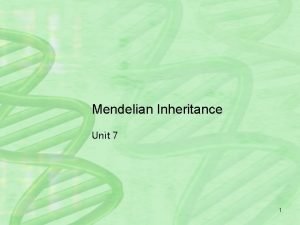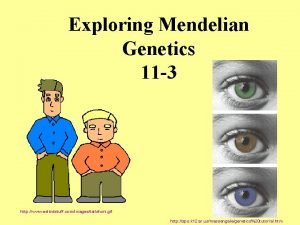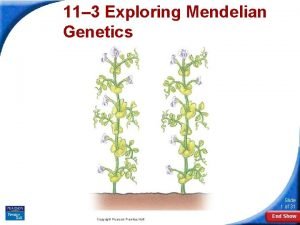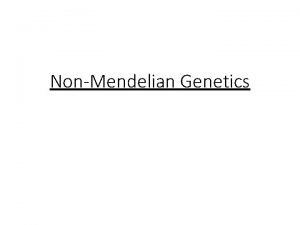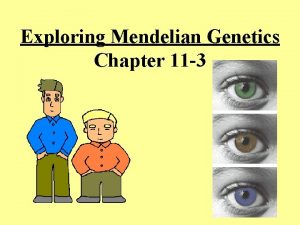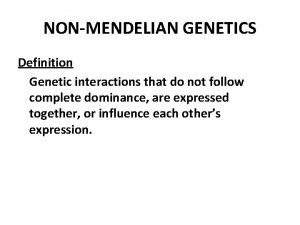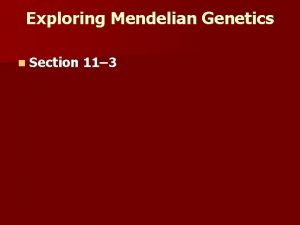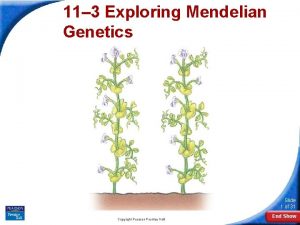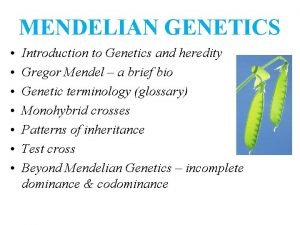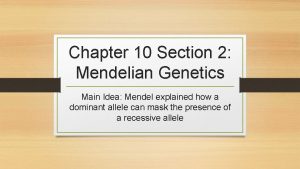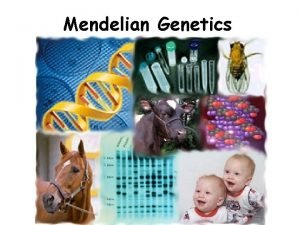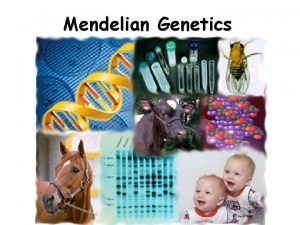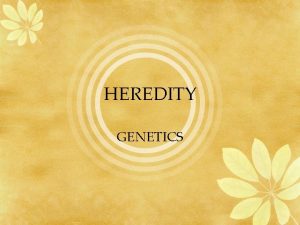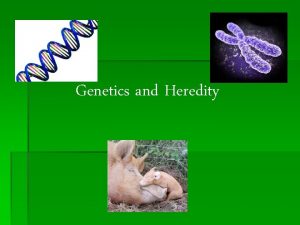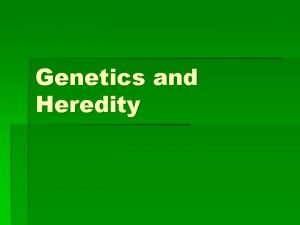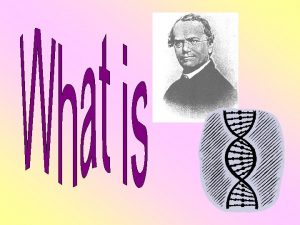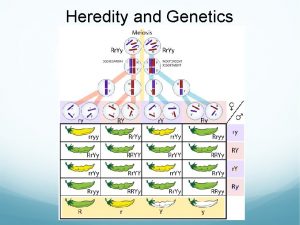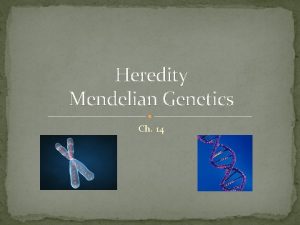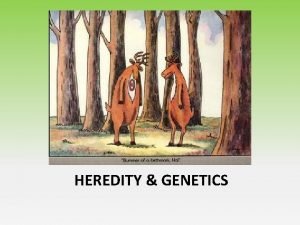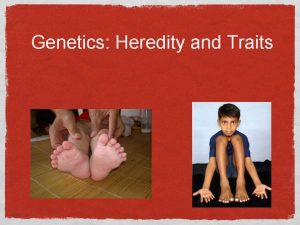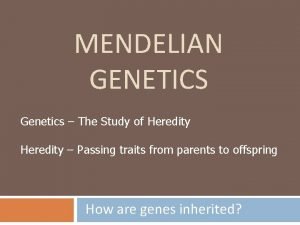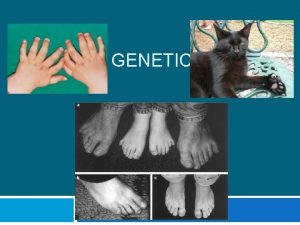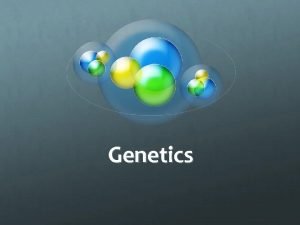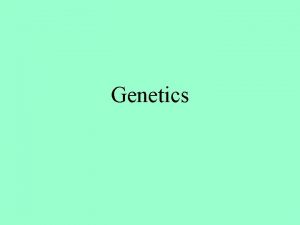Mendelian Genetics Heredity the passing of traits from


















- Slides: 18

Mendelian Genetics

Heredity – the passing of traits from parents to offspring Genetics - The study of heredity

Gregor Mendel “Father of Genetics” Austrian monk who studied patterns of inheritance in Pisum sativum, the garden pea. Used math to discover patterns of inheritance and developed genetic rules to explain them.

Why Study Peas? Only 2 traits for each characteristic (Table 1) Characteristic Contrasting Traits Dom vs. Rec Alleles Dom vs. Rec P p A a Y y R r I i G g T t

Genotype The genetic make-up of an organism Examples: We’re the SAME Homo = “Same” PP (homozygous dominant) Pp (heterozygous) pp (homozygous recessive) Hetero = “Different”

Phenotype The external appearance of an organism Genotype Phenotype PP (homozygous dominant) = Purple Pp (heterozygous) = Purple pp (homozygous recessive) = White Curly Straight

Mendel’s Experiments Monohybrid cross A cross involving 1 characteristic or gene.

Predicting the Outcomes of Monohybrid Crosses: Punnett Square A chart devised by Reginald Punnett in 1905 Used to simulate a cross & predict the likelihood of all possible outcomes. Sperm Eggs

Steps For Using a Punnett Square: 1. Write the genotypes of the individuals to be crossed. Ex #1: Perform a P 1 cross for plant height: TT X tt

Steps For Using a Punnett Square: 2. Draw the Punnett square below them. TT X tt

Steps For Using a Punnett Square: 3. Simulate meiosis by writing the types of sperm the male can produce above the square and the types of eggs the female can produce to the left. T T X t T Eggs T t t t Law of Segregation Sperm

Steps For Using a Punnett Square: 4. Simulate fertilization by filling in the boxes of the square TT X tt Genotypic ratio of F 1: TT : Tt : tt 0 : 4 : 0 100% Tt t T Phenotypic ratio of F 1: Tall : short 4 : 0 100% Dominant Eggs Tt t Sperm Tt F 1 T Tt Tt

Mendel’s Conclusions: 1. Organisms inherit 2 copies of a gene (one from each parent) 2. Genes exist in alternative forms (P vs. p). * Today the different versions of a gene are called alleles. 3. When an organism inherits alleles that are different hybrid, one may totally mask or hide the other. * Mendel described the trait that was expressed in the F 1 the dominant trait - capable of masking its contrasting trait. * He called the trait that was lost in the F 1 only to reappear in the F 2 the recessive trait - the trait that is masked. 4. When gametes are formed, the alleles for each gene separate independently (Law of Segregation)

Mendel’s findings were published before chromosomes were discovered, so scientists couldn’t explain them. Walter Sutton (1900) Proposed the Chromosome theory States that genes are located on chromosomes. Chromosomes occur in pairs, therefore, genes also occur in pairs – one allele per homologue P p

Ex #2: Given: B = Black fur b = brown fur Simulate an F 1 cross: (heterozygous X heterozygous) Bb X Bb Genotypic ratio of F 2: BB : Bb : bb 1 : 2 : 1 Phenotypic ratio of F 2: Black : Brown 3 : 1 B b B BB Bb bb

Dwarfism in dogs is caused by an undesirable recessive allele: D = Normal height d= dwarfism What is the genotype of a dwarf dog? dd What is the genotype of a normal dog? DD or Dd How can we find out which one? Normal and dwarf German Shepherd litter mates.

Perform a test cross Procedure used to determine the genotype of an individual with a dominant phenotype. Mate the unknown with a homozygous recessive individual. Enables us to determine the genotype of unknown individual.

Test Cross If we have a normal dog, we can breed it with a dwarf to determine if it carries a hidden dwarf allele DD X dd d d D Dd Dd or If unknown is homozygous dominant, offspring will be 100% normal. Dd X dd d d D Dd Dd d dd dd If unknown is heterozygous, offspring will be 50% normal, 50% dwarfs.
 Difference between mendelian and non mendelian inheritance
Difference between mendelian and non mendelian inheritance Genetics is the study of heredity and variation.
Genetics is the study of heredity and variation. Chapter 17 the beginning of the life cycle
Chapter 17 the beginning of the life cycle 11-3 exploring mendelian genetics
11-3 exploring mendelian genetics Mendelian genetics
Mendelian genetics 11-3 exploring mendelian genetics
11-3 exploring mendelian genetics Dominant
Dominant How to do a punnett square for color blindness
How to do a punnett square for color blindness Section 11-3 exploring mendelian genetics
Section 11-3 exploring mendelian genetics Penetrance
Penetrance Section 11-3 exploring mendelian genetics
Section 11-3 exploring mendelian genetics Purebred vs hybrid
Purebred vs hybrid 11-3 exploring mendelian genetics answers
11-3 exploring mendelian genetics answers Section 11-4 meiosis answer key
Section 11-4 meiosis answer key Heredity concept map
Heredity concept map Codominace
Codominace Chapter 10 section 2 mendelian genetics
Chapter 10 section 2 mendelian genetics The scientific study of heredity *
The scientific study of heredity * Holandric genes
Holandric genes
